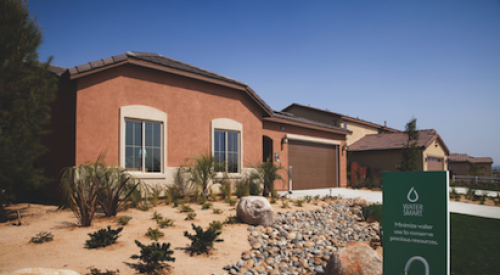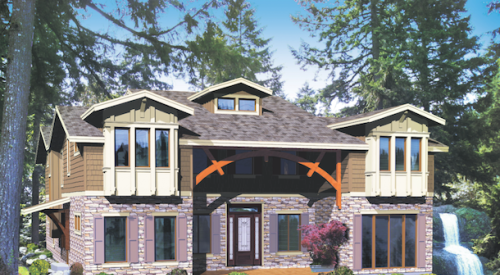 David Bennert, co-founder of Innova Homes. |
Modular homes are built in a factory and shipped to the job site, where they are fastened to the foundation and each other. A project might take only a few months, making cash flow more manageable and reducing financing costs. A simple home made from two modular pieces can be done in 30-45 days and a Cape Cod in 45-90, Bennert notes, adding that because the factory work is completed at a fixed price, there's less room for budget errors.
"The homes are also better-sealed and less prone to mold since they're constructed in a dry environment with well-stored and well-maintained materials," says Bennert. They generate less construction waste, too.
Innova Homes began working with green modular homes in 2005, when a developer approached Bennert to build an environmentally friendly spec home. Bennert decided to go one step further and created a niche market by building green modular homes.
To get a stamp of approval that would resonate with customers, he decided to build to the standards of North Carolina HealthyBuilt Homes, which provides a certificate for North Carolina homes that use less energy and water, have healthy indoor air and protect the land where the home is built.
Bennert and his partner discovered that building a modular home gave them a significant head start toward certification.
Bonus PointsBuilding a modular home versus a standard home makes green certification easier, Bennert found.
"In all, the modular process takes care of about 10 percent of the points toward certification, which put us ahead of the curve compared to a site builder," he says.
"By nature, modular homes are generally better-sealed, so that puts you ahead. Also, the modular process itself minimizes waste. They receive much of their wood pre-cut to length and then have programs for recycling the extra, which also earned us points."
Because certification requirements vary by program, Bennert's partner, Tanya Williams, advises other builders to do their homework up front to determine which features of the modular construction will apply. It isn't always immediately apparent.
"A lot of the materials that the modular manufacturer is already using are green, even though they aren't necessarily marketed that way," says Williams. The company used gypsum, which comprises recycled materials; oriented strand board, which comes from fast-growth forests; and formaldehyde-free fiberglass insulation — all point-earning steps. "That was a pleasant surprise," he says.
 Workers guide a second story module, above, into place with the help of a crane. |
Bennert's first green home included these features, as well as a precast concrete foundation; smart zoning controls; HVAC equipment and ducts in conditioned space; insulation 20 percent above code; Low-E windows; Energy Star qualified appliances; fluorescent lighting; recycled-content carpet and padding; and xeriscaping practices for landscaping.
CommunicationInnova Homes worked with the modular home factory to make sure the home met green certification requirements. One challenge came, for example, when Innova Homes asked for the building process or standards to change to meet specific green requirements.
"When a company is putting out two or four homes a day and you tell them that you want your home built with finger-jointed studs or an alternative to OSB, it's difficult for them to bring in material for that specific home," Bennert says. "Sometimes it's impossible because they are often locked in with specific products' distributors. Even when it is possible, the administrative, handling, storage and transportation issues are difficult to handle in a production environment.
"Still, there remain a lot of opportunities that the modular companies could bring to the market and to GCs like me without a whole lot of effort," Bennert says.
Simple construction changes he recommends include using insulated headers, engineered lumber, additional air sealant and better insulating procedures.
"Once they realize that there is a market for these upgrades, I think they will be more receptive because it will allow them to differentiate their product in the market."
The Nitty GrittyBuilding green modular homes proved to be a bit of an experiment.
"We didn't know how much going green would cost us; we didn't know which green items would be easiest to implement; we didn't understand what the documentation requirements would ultimately be."
As a newcomer to the process, he documented thoroughly, talked with manufacturers and energy specialists, and attended trainings on green building. The result was a comprehensive understanding of what it takes to build green that Bennert says will help him in all upcoming projects.
"The first time around, it cost us about $10,000 in administrative costs to make the modular home green, including all the time spent on research, documentation and certification," Bennert says. "This was our up-front investment in going green, although I did more than most people have to. We expect that the basic green certification in the future will cost only $2,000 to $3,000. This would include upgrades that get the house up to Energy Star standards."
The homeowner can quickly recoup these costs through lower utility bills. An energy model indicated that the home would save $437 in heating and cooling costs a year, and Bennert estimates another $200 to $250 in lighting and appliances, for a pay-back of only 3 to 5 years.
Reaping the RewardsBennert says his payoff was worth the extra cost and planning for the green building certificate.
"It was a very successful experiment. It has given us a huge amount of exposure and a niche market, which is where we want to be," Bennert says.
The local newspaper covered the project — the first green modular home certified by North Carolina HealthyBuilt Homes — which generated a lot of interest in the home.
 |
"A major benefit of earning a green certification is that it demonstrates the attention to detail you put into the home. You can't get a HealthyBuilt Home certification without attention to detail, because a home is certified through a series of third-party inspections," Bennert says.
"The certification will obviously attract people who are looking for a green home, but it is also a powerful marketing tool to target consumers that are simply looking for what we all want — a quality home."
The Partnership for Advancing Housing Technology is administered by the U. S. Department of Housing and Urban Development.
Did PATH answer your questions about this technology?











